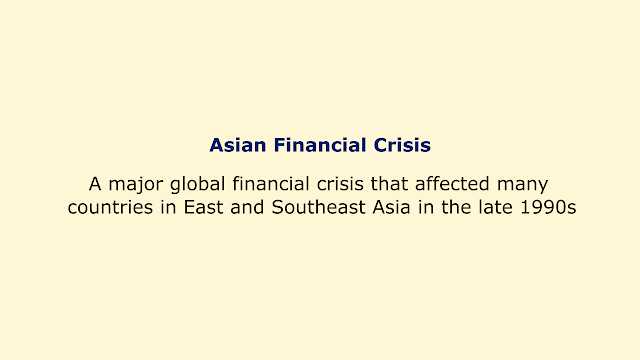 |
| Image: Moneybestpal.com |
Many countries in East and Southeast Asia were impacted by the Asian Financial Crisis, a significant worldwide financial catastrophe that occurred in the late 1990s. After using up all of its foreign exchange reserves to protect the baht from speculative attacks, the Thai government chose to let the currency float in July 1997, which is where it all began.
With devastating social and political repercussions, this set off a domino effect that resulted in currency devaluations, capital outflows, stock market crashes, and bank failures throughout the area.
The causes of the crisis are complex and debated, but some of the main factors include:
The response to the crisis varied across countries, but generally involved a combination of:
The causes of the crisis are complex and debated, but some of the main factors include:
- An area that is experiencing a rapid expansion of credit and capital inflows, driven by cheap interest rates in affluent nations and strong returns in emerging economies.
- The absence of sufficient control and oversight of the financial industry, particularly the banking system, which participated in hazardous lending practices and had a large exposure to foreign debt.
- Fixed or pegged exchange rate regimes did not reflect the underlying economic conditions of the countries, making the currencies susceptible to speculative attacks.
- The crisis spreads from one nation to another through trade, finance, and investor confidence channels, which is known as the contagion effect.
The response to the crisis varied across countries, but generally involved a combination of:
- Macroeconomic adjustments to regain confidence and external balance, such as boosting interest rates, tightening fiscal policy, and depreciating the currency.
- Restructuring of the financial industry, including the closure of insolvent institutions and the recapitalization of viable ones, as well as tighter regulation and oversight.
- Structural reforms, such as boosting corporate governance, accountability, and transparency, and advancing social safety nets.
The lessons learned from the crisis are also numerous and contested, but some of the main ones include:
- How crucial it is to practice solid macroeconomic management, particularly when it comes to upholding a flexible exchange rate system that can respond to external shocks and avoid currency mismatches.
- The importance of responsible financial regulation and supervision, particularly in terms of ensuring that banks and other financial institutions meet minimum requirements for capital, liquidity, and risk management.
- Improving financial surveillance, crisis prevention, and resolution procedures among Asian countries; the function of regional cooperation and coordination.
- Achieving a development model that is more inclusive, balanced, and capable of reducing social unrest, poverty, and inequality. the difficulty of balancing growth with stability.
